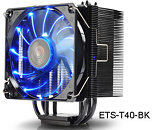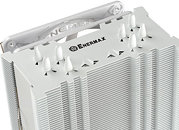- Joined
- Oct 9, 2007
- Messages
- 47,889 (7.38/day)
- Location
- Dublin, Ireland
| System Name | RBMK-1000 |
|---|---|
| Processor | AMD Ryzen 7 5700G |
| Motherboard | Gigabyte B550 AORUS Elite V2 |
| Cooling | DeepCool Gammax L240 V2 |
| Memory | 2x 16GB DDR4-3200 |
| Video Card(s) | Galax RTX 4070 Ti EX |
| Storage | Samsung 990 1TB |
| Display(s) | BenQ 1440p 60 Hz 27-inch |
| Case | Corsair Carbide 100R |
| Audio Device(s) | ASUS SupremeFX S1220A |
| Power Supply | Cooler Master MWE Gold 650W |
| Mouse | ASUS ROG Strix Impact |
| Keyboard | Gamdias Hermes E2 |
| Software | Windows 11 Pro |
After the successful launch of the ETS-T40 series, Enermax now presents a new line of CPU Coolers in the series, the ETS-T40-Black Twister (ETS-T40-BK) and ETS-T40-White Cluster (ETS-T40-W). The new lineup not only inherits the superior performance of the ETS-T40 series with patented technologies, but also features an attractive heat sink decked out in a stunning coat, increasing the options and appeal of the ETS-T40 series family.
Black Twister and White Cluster are available in midnight black and arctic white colors, respectively. Both models employ a unique TCC (Thermal Conductive Coating) to create better velocity of thermal transference and prevent oxidation on the contact surface. ETS-T40-Black Twister features a circular blue LED PWM fan for a mesmerizing presentation. On the other hand, ETS-T40-White Cluster is equipped with the white LED fan with the unique PWM APS (Adjustable Peak Speed) control which offers 3 peak RPM options to satisfy the needs of consumers who prefer manual adjustability.





Enermax is committed to continually develop new and innovative cooling solutions. Both Black Twister and White Cluster feature several Enermax's patented technologies - the VGF, SEF, and VEF. The VGF (Vortex Generator Flow) helps increase air convection in-between the radiator fins; the SEF (Stack Effect) enhances heat transference from the bottom up; the VEF (Vacuum Effect) optimizes airflow inside the cooler. Furthermore, ETS-T40 employs four Ø6mm heat pipes with HDT (Heat-pipe Direct Touch) structure to shorten the distance between CPU and CPU Cooler, which vastly improves the thermal conduction.
Enermax ETS-T40 series CPU coolers come with a universal bracket for Intel LGA 775 / 1150 / 1155 / 1156 / 1366 / 2011 and AMDAM2 / AM2+ / AM3 / AM3+ / FM1 / FM2 platforms. All Enermax CPU Coolers are Haswell compatible. ETS-T40-Black Twister and ETS-T40-White Cluster will be available in US in July 2013 at MSRP of US$49.99.
For more information, visit the product pages of ETS-T40-BK and ETS-T40-W.
View at TechPowerUp Main Site
Black Twister and White Cluster are available in midnight black and arctic white colors, respectively. Both models employ a unique TCC (Thermal Conductive Coating) to create better velocity of thermal transference and prevent oxidation on the contact surface. ETS-T40-Black Twister features a circular blue LED PWM fan for a mesmerizing presentation. On the other hand, ETS-T40-White Cluster is equipped with the white LED fan with the unique PWM APS (Adjustable Peak Speed) control which offers 3 peak RPM options to satisfy the needs of consumers who prefer manual adjustability.





Enermax is committed to continually develop new and innovative cooling solutions. Both Black Twister and White Cluster feature several Enermax's patented technologies - the VGF, SEF, and VEF. The VGF (Vortex Generator Flow) helps increase air convection in-between the radiator fins; the SEF (Stack Effect) enhances heat transference from the bottom up; the VEF (Vacuum Effect) optimizes airflow inside the cooler. Furthermore, ETS-T40 employs four Ø6mm heat pipes with HDT (Heat-pipe Direct Touch) structure to shorten the distance between CPU and CPU Cooler, which vastly improves the thermal conduction.
Enermax ETS-T40 series CPU coolers come with a universal bracket for Intel LGA 775 / 1150 / 1155 / 1156 / 1366 / 2011 and AMDAM2 / AM2+ / AM3 / AM3+ / FM1 / FM2 platforms. All Enermax CPU Coolers are Haswell compatible. ETS-T40-Black Twister and ETS-T40-White Cluster will be available in US in July 2013 at MSRP of US$49.99.
For more information, visit the product pages of ETS-T40-BK and ETS-T40-W.
View at TechPowerUp Main Site







